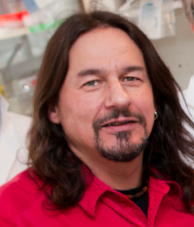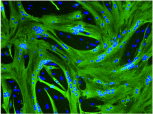In addition to its research activities at the Myology Centre for Research, Team 3 has a service activity for the international scientific community, a platform for producing and sharing immortalised human cell lines.
 Vincent Mouly, is the Director of Team 3 and began work on the immortalisation of human muscle cells in 1994. At the time, the objective was to have sufficient quantities of biological material for a given disease, or even several mutations of the same disease, in order to study the pathophysiological mechanisms and/or to test therapeutic approaches. The first cell line was established 13 years later, in 2007. To date, the platform, which is run by A. Bigot and K. Mamchaoui, both employees of AIM/AFM, has generated nearly 80 immortalised muscle cell lines covering many neuromuscular diseases, and 8 lines of healthy cells which serve as controls.
Vincent Mouly, is the Director of Team 3 and began work on the immortalisation of human muscle cells in 1994. At the time, the objective was to have sufficient quantities of biological material for a given disease, or even several mutations of the same disease, in order to study the pathophysiological mechanisms and/or to test therapeutic approaches. The first cell line was established 13 years later, in 2007. To date, the platform, which is run by A. Bigot and K. Mamchaoui, both employees of AIM/AFM, has generated nearly 80 immortalised muscle cell lines covering many neuromuscular diseases, and 8 lines of healthy cells which serve as controls.
 The immortal cell lines are derived from cells from patient tissues, muscle biopsies and surgical residues. Cells from diseased tissue are rare and fragile and have very few divisions left before they stop dividing definitively (e.g. surgical waste collected at an advanced stage of the disease). If they are genetically modified, they can proliferate indefinitely. The immortalisation process lasts four month after which the cell suspensions, in conditioning medium, containing 1 million cells are placed in sterile cryotubes and stored in -80° freezers.
The immortal cell lines are derived from cells from patient tissues, muscle biopsies and surgical residues. Cells from diseased tissue are rare and fragile and have very few divisions left before they stop dividing definitively (e.g. surgical waste collected at an advanced stage of the disease). If they are genetically modified, they can proliferate indefinitely. The immortalisation process lasts four month after which the cell suspensions, in conditioning medium, containing 1 million cells are placed in sterile cryotubes and stored in -80° freezers.
(Fig.: Cells differentiated into myotubes (green) as revealed by an anti-myosin antibody)
The team regularly works on tissues from three French biobanks (Institute of Myology –Myobank– with S. Vasseur, Genethon with S. Saker-Delye and l’Hôpital Cochin with F. Leturcq) and a British bank (F . Muntoni in London). Occasionally, the laboratory has requests to immortalise cell lines from international academic research teams or private companies (Prosensa, Biomarin, Sanofi, Bristol-Myers Squibb, etc.). Even though cell lines may be provided free of charge to academic research laboratories, pharmaceutical companies are asked to participate to the production costs. However, whether academic or private, cell lines are prohibited for sale and are assigned for a limited duration and within the context of a specific project. Furthermore, sometimes advice may be given concerning the choice of a cell line or researchers may be trained about the correct use of immortalised cells.
The laboratory ships 100-150 immortalised lines per year. This has enabled laboratories from Britain, Holland and Nantes to test the exon skipping therapeutic approach, but also to validate a new bioinformatics approach for the selection of exon skipping tools (with W. Duddy and T. Yokota). On a more fundamental level, these lines were used to test a new genome editing technology (CRISPR), to develop a three-dimensional culture system for quiescent cells, or test molecules responsible for interactions with the extracellular matrix environment.
> Learn more about the team
> Learn more about the platform for immortalisation of cell lines
